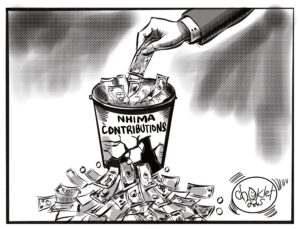THE PF GOVERNMENT DELIVERING ITS PROMISED “HUMAN-CENTRED DEVELOPMENT”; DRIVEN BY ECONOMIC & SOCIAL INFRASTRUCTURE DEVELOPMENT
1. INTRODUCTION
“It is not our wealth that builds our roads, but it is our roads that built our wealth” John F. Kennedy
For centuries the African continent was regarded as a place with: the least share of global trade; negligible intra-continental trade; weak domestic and regional integration, and insignificant industrial expansion, if any.
As part of the African continent, Zambia was not exempt from the abovementioned identity and reality. There were several factors responsible for the above state of affairs, one of them was due to Africa’s and Zambia’s lagging infrastructure development vis-à-vis poor road network, airports, health centres, education facilities- from early childhood to tertiary level. Against this background, it was logical and imperative that Zambia (and rest of Africa) needed to make significant and strategic investments in infrastructure development; in order to grow more significantly from a place of underdevelopment which had beset the continent since the 1970s and 1980s.
Therefore, there is consensus among well-meaning and knowledgeable Zambians that the country urgently needs to accelerate its infrastructure development programmes (roads, schools, hospitals, airports, maritime transport, social housing, portable drinkable water services, electricity, to name but a few) to significantly improve the well-being of the masses countrywide, but also make the country more competitive regionally if Zambia is to become an economic force to be reckoned with. Infrastructure development is a crucial pre-requisite for industrialization and diversification of the economy.
Clearly, human-centred development, and Zambia becoming a regional economic hub, are impossible tasks without developing economic and social infrastructure such as all-weather road networks in both rural and urban areas, access to education and health care for all, international standard airports, maritime transport systems, social housing, portable drinkable water services, rural and urban electrification systems, among others.
For the Patriotic Front (PF) as per its comprehensive manifesto, infrastructure development is critical in achieving Zambia’s objective of becoming a prosperous middle-income country by the year 2030 as enshrined in the Vision 2030 and other national strategic documents.
In order to achieve the goals enshrined in the Vision 2030; Zambia needs “levers” to reposition itself for more robust, inclusive and sustained economic growth and development which will be the means to an end; ‘the end’ being the significant improvement of the welfare of all Zambians by 2030 and beyond.
The words of Archimedes still challenge us today when he proclaims so boldly:
“Give me a lever long enough and a fulcrum on which to place it and I shall move the world!”
To paraphrase Archimedes, our beloved country is crying out to us saying: “Give me a foundation to stand, a ‘lever’ strong and long enough to connect every citizen and place; and I will uplift the economy, society and human well-being!”
Undoubtedly, one of the “levers” which shall connect every Zambian and place to uplift the wellbeing of the masses is economic and social infrastructure development. It is important to note that this PF strategic drive is consistent with national and international strategic documents such as the Vision 2030, the 7NDP, AU Agenda 2063, to mention but three.
2. Infrastructure Development and Sustainable Development
Simply put, “development” is all about bringing positive change in people’s lives.
Without pre-empting the article, the reader needs to ask the question:
“Does infrastructure development (all-weather roads, accessible schools and hospitals, international standard airports, maritime transport systems, social housing, portable drinkable water services, rural and urban electrification systems, and so on) bring about positive change in the lives of the people and society?”
Indeed, power (energy), transportation (road, rail, air, maritime), portable drinkable water and sanitation – sometimes referred to us “hard” infrastructure – are of paramount importance to the economic growth and development of any country.
This is the reason why the PF government – under the leadership of the late President, His Excellency Mr. Michael C. Sata (MHSRIP) and now under the able leadership of His Excellency President Edgar Chagwa Lungu – remains resolute to deliver infrastructure development as a means of bringing about inclusive economic growth and development, and improved human wellbeing.
As a pro-poor party, the PF government believes that broad-based development and poverty reduction is about – among other things, meeting basic needs such as portable drinkable water, Health Facilities, Educational Institutions, food, as well as decent and affordable shelter and sanitary services. This is critical in order to bring about smart and sustainable urban development for a Zambia without slums. The PF is leading the delivery of these mega “human-centred” development programmes through public and private channels such as the public-private partnership (PPP) model.
3. CONSEQUENCES OF ZAMBIA’S LAGGING INFRASTRUCTURE DEVELOPMENT: THE TOLL ON SUSTAINABLE DEVELOPMENT EFFORTS
So, why does the PF care about infrastructure development? Does it really matter? Are there any costs for lagging infrastructure development?
Undoubtedly, Zambia’s efforts to reach the desired levels of human-centred “sustainable development” (that is, economic, environmental, social and human development) have been hampered by inadequate, poor and/or lack of infrastructure – at a great cost to the nation.
Evidently, Zambia has paid an extremely high price for lagging infrastructure development economically, socially and environmentally because; infrastructure is the foundation and core “input” to all other “output” in any economy. This is true because as “economic infrastructure” such as transportation (road, rail, air, maritime) is being utilized in rural and urban areas, it will facilitate more robust and inclusive economic growth and development. However, the absence of such economic infrastructure only perpetuates poverty and underdevelopment.
More specifically, if Zambia does not urgently develop its economic and social infrastructure, the country may suffer the following dire consequences:
a) Low Competitiveness: Low quantity, low quality and less access to infrastructure seriously hampers a country’s competitiveness at regional, continental and global levels. In the case of Zambia, such low competitiveness due to lack of adequate infrastructure could in turn hamper foreign direct investment in manufacturing and other strategic industries which the country intends to develop.
b) Poverty and Inequality: Failure to equitably provide infrastructure such as sanitation and portable safe water in both rural and urban areas creates inequalities in accessing such infrastructure.
As a result, this inequitable access to economic and social infrastructure has the potential to significantly entrench poverty; as well as reduce the capacity of households to prevent diseases which arise from a lack of sanitation and portable safe water infrastructure.
c) Slower growth: As established above, lack of or lagging infrastructure leads to lack of competitiveness and low market integration. This in turn leads to slow economic growth for Zambia, which further exacerbates low competitiveness, poverty and inequality between rural and urban areas; between male and female, nationwide.
d) Weak market integration: In order to achieve the desired human-centred development and poverty reduction in Zambia, any responsible Government would aim at integrating Zambia’s domestic economy. This is a goal which any responsible citizen would fully support. However, to integrate Zambia’s domestic economy means developing quality transportation networks (road, rail, air, maritime); Health facilities, Educational Institutions (early childhood to tertiary) and among others, countrywide. The resulting market integration and linkages will enable subsistence rural and urban farmers to achieve commercial production levels.
Furthermore, this domestic market integration will lower risks in rural and urban areas, thus significantly reducing the chances of the people falling into poverty or remaining trapped in poverty.
It is not possible to exhaust why and how the PF Government is delivering on its promise of “human-centred development” driven by economic & social infrastructure development in one article. In the sequel to this article, we will demystify some anti-development myths and destroy the unlearned question; “Do we eat roads?”.
In the meantime, the PF Government continues to work on Social and Economic Infrastructure development, which ultimately significantly improves the well-being of each and every Zambian countrywide, and also makes our nation more competitive regionally.
(Hon Davies Mwila is Secretary General of the Patriotic Front)
























